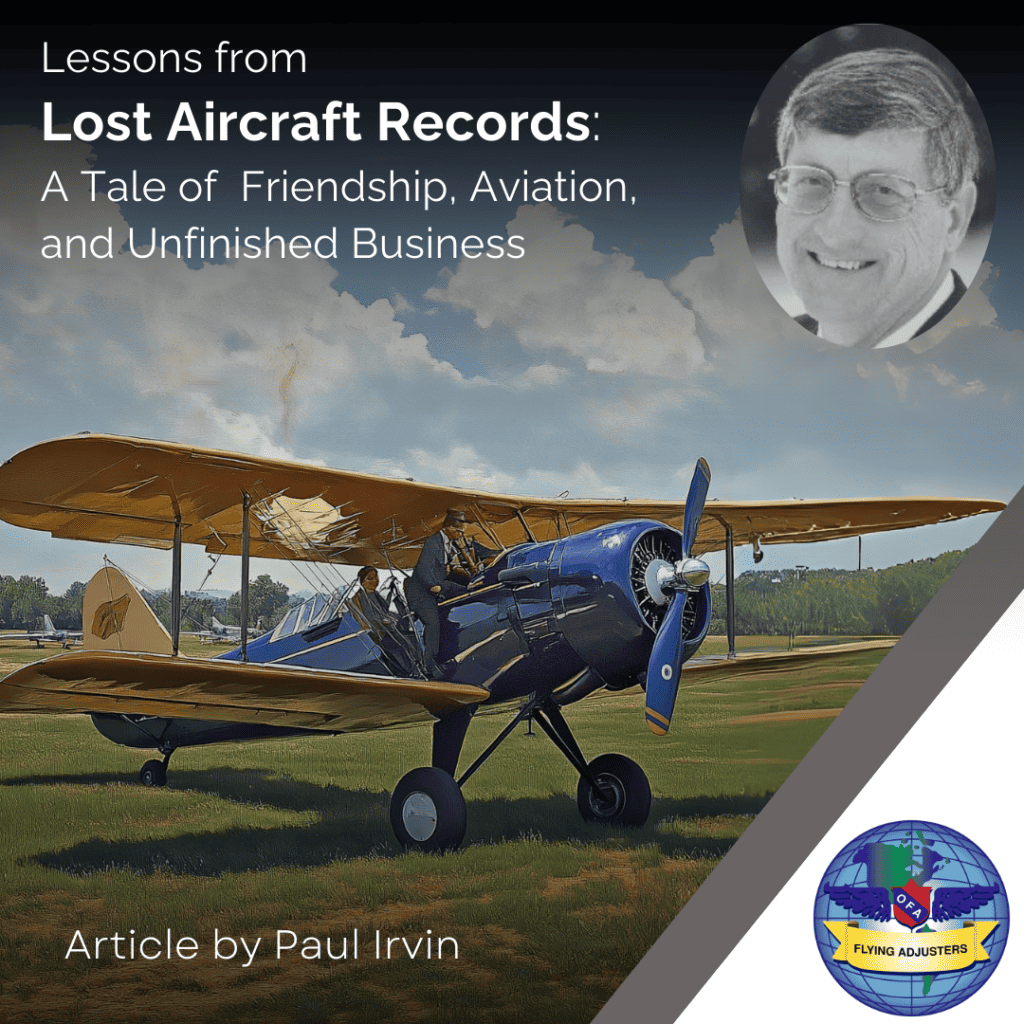By Paul Irvin,
A/P – IA, Sr. Appraiser PSCA
Background: A Tale of Friendship, Aviation, and Unfinished Business
In the rural heartland, two aviation enthusiasts—an elderly farmer and his neighbor—shared a deep passion for flight. The farmer, a widower, dedicated his days to tending his crops, while the woman, a divorcee, managed her own property just a few miles away. Though close friends, the farmer repeatedly proposed marriage, only to be met with a gentle refusal. Despite this, their companionship endured, bound by their shared love for aviation.
Both owned aircraft and maintained private runways on their properties. The farmer’s airstrip lay behind his barn, allowing him to take off whenever the skies called. The woman, on the other hand, kept two aircraft in a hangar near her home, just as deeply invested in the aviation lifestyle as her friend.
Around 2012, one of the woman’s aircraft—a vintage 1950s model—required maintenance and an annual inspection. The farmer, ever the supportive friend, agreed to finance the repairs and even assisted with some of the work. They enlisted the help of a mechanic, recognizing that restoring an aircraft of this era would be no small feat. However, partway through the inspection process—approximately 60% complete—the farmer, due to financial constraints, instructed the mechanic to pause the work. The mechanic was fully paid, but a financial agreement was drafted between the two friends, with records and aircraft logbooks stored in the farmer’s hangar office for safekeeping. Unfortunately, no further work was done on the aircraft for over a decade.
Tragedy Strikes: The Legal Battle Begins
Time passed, and life took its inevitable toll. The farmer eventually succumbed to illness, and within 18 months, the woman also passed away. What should have been a smooth transition of assets turned into a legal quagmire, as both estates laid claim to the aircraft.
The financial agreement—proof of the farmer’s financial investment in the aircraft—was nowhere to be found. To complicate matters further, the aircraft logbooks were missing as well. There were no liens recorded with the county, state, or the FAA, making it impossible to legally substantiate any claims of ownership.
Estate A argued that the farmer had invested thousands into the aircraft, while Estate B contested, demanding proof. Without documentation, what followed was a bitter dispute involving lawyers, family feuds, and growing distrust. In the midst of this legal battle, a certified aircraft appraiser was called upon to assess the value of the aircraft in question. Meanwhile, the farmer’s aircraft had been sold to his longtime flying partner, leaving only the woman’s two planes at the center of the dispute.
The Condition of the Hangar and Its Hidden Secrets
The appraiser’s job became even more complicated upon assessing the hangar. The woman had suffered from a severe hoarding disorder, filling both her home and hangar with piles of belongings. Boxes of clothing, household goods, and miscellaneous items blocked access to much of the space. The cleanup effort required the removal of:
- Two 30-yard dumpsters and five 20-yard dumpsters of discarded material
- Three truckloads of clothing
- Countless boxes meticulously sorted for valuables
Hidden within this chaos were valuable items—jewelry, money, and antiques—yet the most crucial documents remained missing. The letter of agreement between the farmer and the woman? Gone. The logbooks for both aircraft? Lost.
Rumors surfaced that the engine from a 1925 Travel Air 2000 had been removed from the property, further complicating matters. Eventually, it was discovered buried under blankets inside the hangar, along with two additional engines that had been relocated to the farmer’s garage. However, due to the lack of paperwork, logbooks, or proof of modifications, the value of these aircraft plummeted. Their only option? To be sold and transported via truck and trailer, as neither could be flown out.
The Appraiser’s Dilemma: How to Assign Value Without Records
With no logbooks and no clear paper trail, the appraiser faced a significant challenge. To make matters more intriguing, claims emerged that the Travel Air 2000 was featured in Richard Bach’s book “Nothing by Chance.” However, upon investigation, it was discovered that the dates of aircraft ownership did not align with the book’s publication, rendering the claim false.
Despite this, the aircraft did appear in the film adaptation of “Nothing by Chance,” which can be viewed on YouTube. This added a layer of historical significance, but without the logbooks, the loss of value was undeniable.
For aviation enthusiasts and history buffs, the film remains a compelling watch—a reminder of the romance of early aviation and the importance of preserving an aircraft’s story.
The High Cost of Lost Aircraft Records
This case serves as a cautionary tale for all aircraft owners. The financial, legal, and emotional costs of lost documentation can be staggering. The absence of logbooks alone can diminish an aircraft’s value by 30-50% or more, depending on its history and condition.
Beyond monetary losses, the lack of documentation led to broken relationships, legal battles, and a legacy tainted by unresolved disputes. The takeaway is clear: organization and record-keeping are paramount in aviation ownership.
Recommendations for Protecting Aircraft Value and Ownership
To avoid the pitfalls of this unfortunate situation, aircraft owners should take proactive steps to protect their records and preserve their aircraft’s value:
- Digitize Important Documents:
- Scan and store logbooks, financial agreements, maintenance records, and title documents in a secure cloud-based system.
- Keep multiple backups (digital and physical) in separate locations.
- Scan and store logbooks, financial agreements, maintenance records, and title documents in a secure cloud-based system.
- Maintain Up-to-Date Records:
- Logbooks should be meticulously updated with airframe, engine(s), propeller(s), and modifications.
- Include the current weight and balance information and a complete equipment list.
- Logbooks should be meticulously updated with airframe, engine(s), propeller(s), and modifications.
- Ensure Legal Security:
- File liens or legal claims appropriately if financial agreements are made.
- Keep a notarized agreement when aircraft are financed, co-owned, or stored on another person’s property.
- File liens or legal claims appropriately if financial agreements are made.
- Safeguard Supplemental Type Certificates (STCs):
- Any modifications to the aircraft should be documented with STCs, as they serve as legal proof of authorized installations.
- Any modifications to the aircraft should be documented with STCs, as they serve as legal proof of authorized installations.
- Educate Family Members & Executors:
- Ensure that those handling the estate understand the importance of logbooks and aircraft documentation.
- Consider creating a checklist for family members on how to access and secure these records.
- Ensure that those handling the estate understand the importance of logbooks and aircraft documentation.
Final Thoughts
This true story is a stark reminder of what’s at stake when documentation is lost. For aircraft owners, a lack of organization can lead to financial losses, legal nightmares, and family disputes. Proper record-keeping is not just a matter of compliance—it’s an investment in the aircraft’s future value.
As an aircraft appraiser, my role is to provide an unbiased, professional valuation based on available records, aircraft condition, and market trends. But without the right paperwork, even the most significant historical aircraft can lose their worth.
If you own an aircraft, take action today. Secure your records, digitize them, and protect your legacy.

